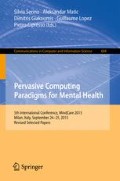Abstract
Researchers have proved immersive Virtual Reality (VR) to be an effective method and non-pharmacological analgesic for distracting acute pain and chronic pain, and for reducing anxiety levels. VR has been developed and deployed in pain management contexts in medical settings for dental and medical procedures, as well to manage cancer and burn pain. Often, what patients are distracted by can typically be described as immersive VR games. Although this is promising, and although the cost of VR has dramatically fallen in the past few years, most VR systems are still comparatively expensive in terms of accessibility for patients in their everyday contexts, such as at home or at work. For most patients — especially chronic pain patients — it is important that pain-related VR is accessible when it is needed, or “just” needed. However, the so-called Cardboard VR is affordable enough for everyday use. It provides a low-cost stereoscopic display that patients attached to smartphones. Therefore, a mobile VR game has been designed, developed and tested for this purpose. This paper describes the game design and game mechanics of Cryoblast, a mobile VR game for self-managing pain. We introduce the design of the gameplay and pain metaphors, and believe it will inspire more mobile VR games for healthcare.
Access this chapter
Tax calculation will be finalised at checkout
Purchases are for personal use only
References
Hoffman, H.G., Chambers, G.T., Meyer, W.J., Arceneaux, L.L., Russell, W.J., Seibel, E.J., Richards, T.L., Sharar, S.R., Patterson, D.R.: Virtual reality as an adjunctive non-pharmacologic analgesic for acute burn pain during medical procedures. Ann. Behav. Med. 41(2), 183–191 (2011). Publ. Soc. Behav. Med.
Steele, E., Grimmer, K., Thomas, B., Mulley, B., Fulton, I., Hoffman, H.: Virtual reality as a pediatric pain modulation technique: a case study. Cyberpsychol. Behav. 6(6), 633–638 (2003)
Hoffman, H.G., Garcia-Palacios, A., Patterson, D.R., Jensen, M., Furness, T., Ammons, W.F.: The effectiveness of virtual reality for dental pain control: a case study. Cyberpsychol. Behav. 4(4), 527–535 (2001). Impact Internet Multimed. Virtual Real Behav. Soc.
Carlin, A.S., Hoffman, H.G., Weghorst, S.: Virtual reality and tactile augmentation in the treatment of spider phobia: a case report. Behav. Res. Ther. 35(2), 153–158 (1997)
Rheingold, H.: Virtual Reality: The Revolutionary Technology of Computer-Generated Artificial Worlds-And How It Promises to Transform Society. Simon & Schuster, New York (1992). Reprinted edn
Gibson, J.J.: The Senses Considered as Perceptual Systems, New edition edn. Praeger, Westport (1983)
Das, D.A., Grimmer, K.A., Sparnon, A.L., McRae, S.E., Thomas, B.H.: The efficacy of playing a virtual reality game in modulating pain for children with acute burn injuries: a randomized controlled trial. BMC Pediatr. 5(1), 1 (2005)
Jennett, C., Cox, A.L., Cairns, P., Dhoparee, S., Epps, A., Tijs, T., Walton, A.: Measuring and defining the experience of immersion in games. Int. J. Hum. Comput. Stud. 66(9), 641–661 (2008)
Gold, J.I., Kant, A.J., Kim, S.H., Rizzo, A.S.: Virtual anesthesia: the use of virtual reality for pain distraction during acute medical interventions. Semin. Anesth. Perioper. Med. Pain 24(4), 203–210 (2005)
Gorini, A., Riva, G.: The potential of virtual reality as anxiety management tool: a randomized controlled study in a sample of patients affected by generalized anxiety disorder. Trials 9(1), 25 (2008)
Grimshaw, M., Charlton, J., Jagger, R.: First-person shooters: immersion and attention. Eludamos J. Comput. Game Cult. 5(1), 29–44 (2011)
Mcmahan, A.: Immersion, engagement, and presence: a method for analyzing 3D videogames. In: Wolf, M., Perron, B. (eds.) The Video Game Theory Reader, pp. 67–86. Routledge, New York (2003)
Gromala, D., Tong, X., Choo, A., Karamnejad, M., Shaw, C. D.: The virtual meditative walk: virtual reality therapy for chronic pain management. In: CHI 2015, pp. 521–524, April 2015
Salen, K., Zimmerman, E.: Rules of Play: Game Design Fundamentals. MIT Press, Cambridge (2003)
Shaw, C. D., Gromala, D., Seay, A. F.: The meditation chamber: enacting automatic senses. In: Proceedings of ENACTIVE/07 (2007)
Author information
Authors and Affiliations
Corresponding author
Editor information
Editors and Affiliations
Rights and permissions
Copyright information
© 2016 Springer International Publishing Switzerland
About this paper
Cite this paper
Tong, X., Gromala, D., Amin, A., Choo, A. (2016). The Design of an Immersive Mobile Virtual Reality Serious Game in Cardboard Head-Mounted Display for Pain Management. In: Serino, S., Matic, A., Giakoumis, D., Lopez, G., Cipresso, P. (eds) Pervasive Computing Paradigms for Mental Health. MindCare 2015. Communications in Computer and Information Science, vol 604. Springer, Cham. https://doi.org/10.1007/978-3-319-32270-4_29
Download citation
DOI: https://doi.org/10.1007/978-3-319-32270-4_29
Published:
Publisher Name: Springer, Cham
Print ISBN: 978-3-319-32269-8
Online ISBN: 978-3-319-32270-4
eBook Packages: Computer ScienceComputer Science (R0)

